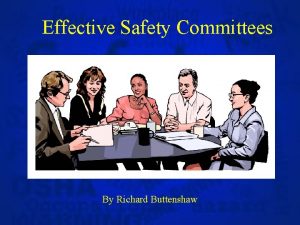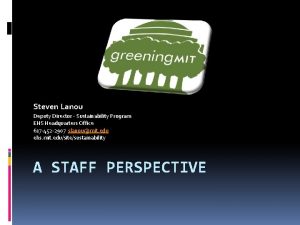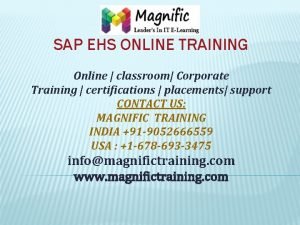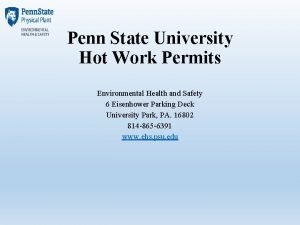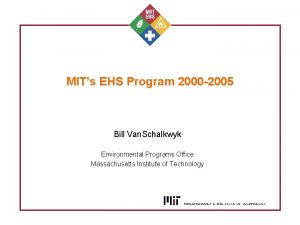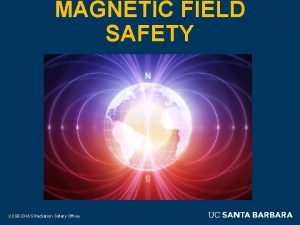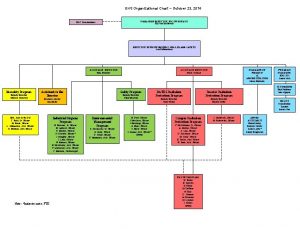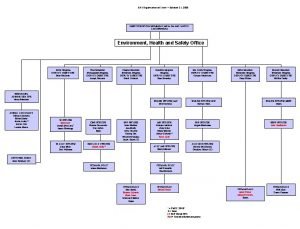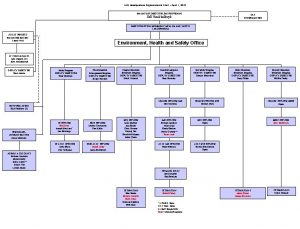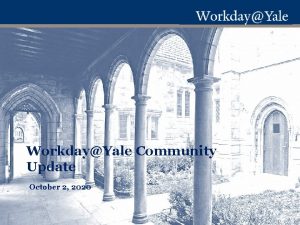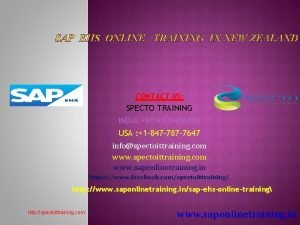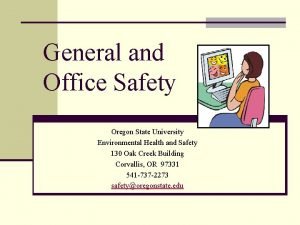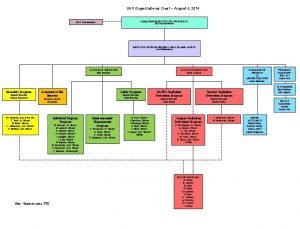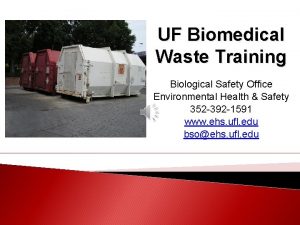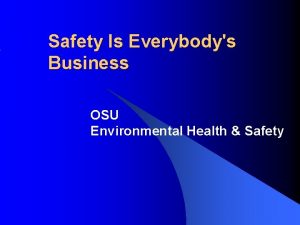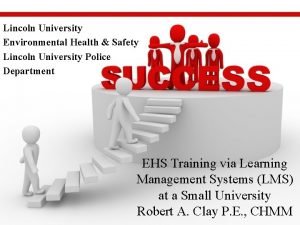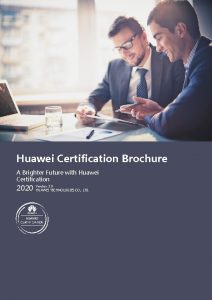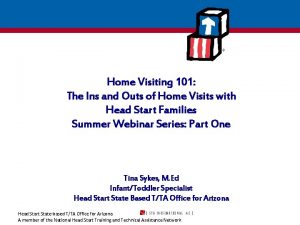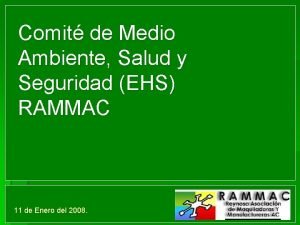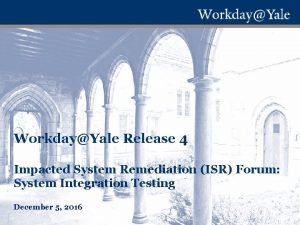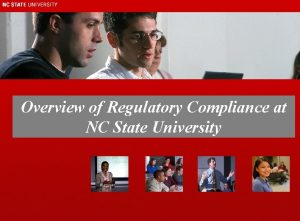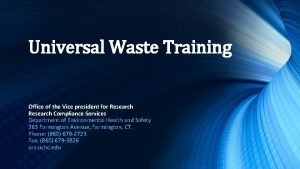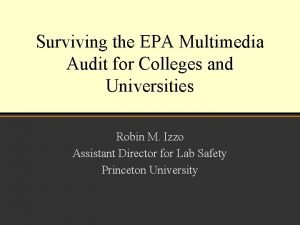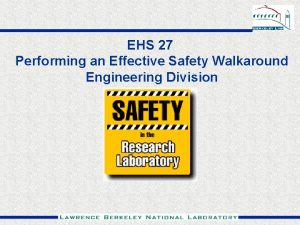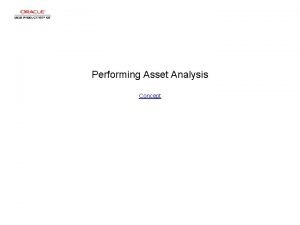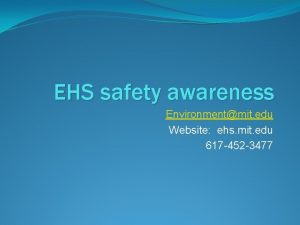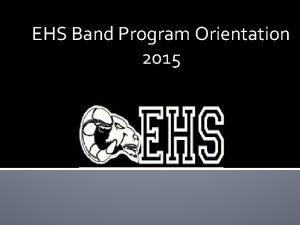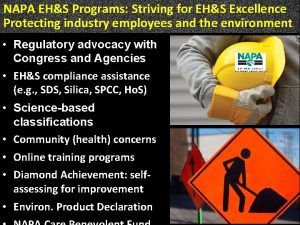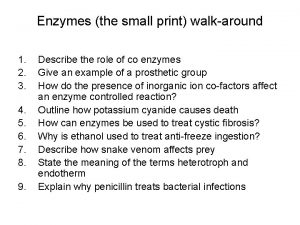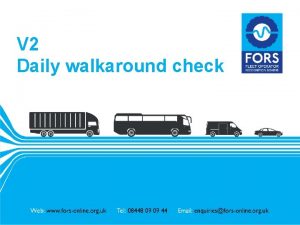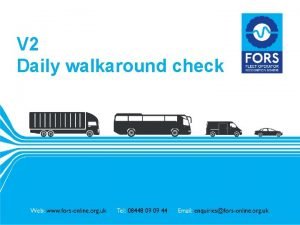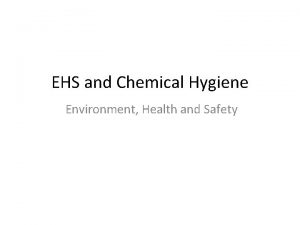EHS 27 Performing an Effective Safety Walkaround Environment






























- Slides: 30

EHS 27 Performing an Effective Safety Walkaround Environment, Health & Safety: Division Management Training Program

Do you believe? A safety walkaround program is one of the most powerful tools a manager/PI has to build safety into every aspect of his/her operation

What’s Wrong? For purposes of this exercise The sign reads, “Do Not Block Exit Door”

What’s wrong? Ø Room exit is blocked by pallets, boxes and other clutter. • Storage is prohibited in all: exit ways, primary hallways and stairwells. • Exit must remain unobstructed at all times. Blocked exits have caused "chain reaction" pileups of fallen people during emergencies. Ø Why was material stored at this location? Ø Why hasn’t this condition been corrected? Ø How would you follow-up to answer these questions? • Is it important to understand why?

What is necessary to observe and correct this safety concern? Ø Tour or inspect the workplace: Conditions like this can emerge quickly, regular walkarounds are more likely to spot trouble quickly Ø Good communications with employees would facilitate them reporting this to you, even if you didn’t see it yourself Ø Know there is a problem: • Employees might know more about specific problems • EHS specialists will support you in walkarounds Ø Take action to correct the problem Ø Follow-up to make sure it was corrected • The blocked stairwell and the underlying cause

Requirement for Walkarounds Ø Lab Requirement – Managers will ensure work is performed safely Ø PUB 3000, Chapter 1. 3. 2 Clear Roles and Responsibilities for ES&H. Managers and Supervisors ensure that: • The Laboratory’s environment, health, and safety policies are being observed within their divisions. • Operations under their control meet all ES&H requirements. • Safety deficiencies identified through inspections are corrected in a timely manner. Ø PY 2006 Division ESH Self-Assessment Criteria • Workspaces are inspected/observed and evaluated on a regular basis. • Divisions review work activities to identify, analyze, and categorize hazards and environmental impacts for the associated work.

Course Objectives Ø Provide information and components of an effective safety walkaround program. Ø Discuss strategies for planning and implementing routine workplace safety walkarounds. Ø Review common deficiencies (OSHA and LBNL specific violations) found in various workspaces and possible corrective actions. Ø Identify methods and resources that assist in the completion and documentation of a safety walkaround. Ø Practice conducting an effective safety walkaround.

Safety walkarounds identify at-risk behaviors and unsafe conditions – preventing more serious accidents Deaths Accidents Lost Time Incidents Recordables First Aid Cases Near Misses Distracted Attitudes Overreaching Improper Tool Use Horseplay At Risk Behavior Culture Consequences

Benefits of a Safety Walkaround Program Cooperation on safety builds trust! Ø #1 - Improves employee safety Ø Communicates safety expectations personally Ø Demonstrates personal leadership Ø Understands how work is being performed (safely, efficiently, etc) Ø Verifies that safety expectations are being met Ø Establishes a mechanism for employees to freely communicate safety issues/concerns Ø Develops key observation & listening skills

Elements of a Safety Walkaround Program 1. Develop and plan your walkaround program. 2. Decide the frequency of and schedule the walkarounds. 3. Understand various formats available: Not one formula, adjust as needed. 4. Focus on work Conditions and Behaviors. 5. Identify and use checklists (tools) for the walkaround and document you walkaround. 6. Understand why things are occurring, not just that they are. 7. Utilize good communication skills: observing, listening, asking… 8. Follow-up with employees on any corrective actions. 9. Ensure issues are entered into CATS - and corrected – document your walkaround. 10. Focus on fixing the problem, not assigning blame.

Safety Walkaround - Planning Ø Develop and advise employees of your walkthrough program – no surprises. Ø Determine who will perform the walkaround with you (other employees, supervisors, matrix supervisors, Safety Coordinator, EHS staff) Ø Schedule time on your calendar for these walkarounds. Ø Prepare yourself for the walkaround by • Reviewing previous walkarounds • Reviewing the job/hazards/PPE requirements Ø Review your walkaround checklist. • Paperless walkaround Ø Allow time to follow-up on the actions you agreed to and give feedback regularly until actions are completed. Lead by example!

Walkaround - Frequency Ø Decide on a routine schedule and frequency in which the walkaround will be performed. Ø Define what “routine” means and stick to it. The recommendation for routine is at least 30 minutes/week. Ø Allow and schedule these times on your calendar.

Walkaround: Formats, Tools, and Documentation Ø There is no one/best format for conducting walkarounds – develop an approach that fits your organization. Ø Utilize the EH&S Walkaround Inspection Pamphlets, Division checklists, your own checklists, other resources in combination (check before and document after). Ø Document all walkaround inspections, enter deficiencies into CATS!

Walkarounds: Good Safety Communication Ø Begin your observation by talking with employees who work in the area Ø Listen more than you talk Ø Ask questions to understand Ø Always try to get to the underlying issues (WHY, WHY) Ø Try to begin with a positive comment (smile) Ø If there are safety problems – focus on the solution not blame – be helpful! Ø Think of the future – what will happen next week on your walkaround Positive non-punitive collaboration – no-name, no blame

What to observe Ø Observe people at work Ø Reactions of people Ø Personal protective equipment • Head to toe check Ø Body positions and motions (Ergo/Material Handling) Ø Tools and equipment Ø Workspace conditions and orderliness Ø How the work is conducted, work procedures, efficiency, procedures

Walkarounds: Identify and Understanding Why Things Happen We All Make Mistakes. Identifying and understanding why things happen can help you to eliminate errors or hazards. Ø Understand errors and the reasons they exist provides you the information you need to address the management system problem. Ø Plan tangible solutions that may work to eliminate the undesired action or error. ACTIVITY: Should the employee in the picture (at right) be wearing safety glasses? How would you approach him? A helpful attitude is more likely to result in your employee sharing “why” he is not wearing the correct PPE versus just telling him he needs to wear it.

Walkaround: Observation, Listening, Asking When observing focus on observation, listening and asking the right questions. Not having the right answer. “I know material handling is a challenge. What would you recommend to do this job better? How can I help? ”

Walkaround – Imminent Danger Situations During a walkaround, intervene if imminent danger exists! Ø Keep calm Ø Don’t make matters worse by: • startling the employee • discussing possible discipline Ø In a calm voice, ask employee to stop work Ø Show concern! Show respect! Ask questions! Ø Get an agreement on how to safely perform the job Ø Follow up if necessary You have an obligation and the authority to stop work if imminent danger exists

Walkaround – Feedback and Follow-up Ø Ø Ø Provide feedback. Be positive. Make a lasting impression. Let employees know what the next steps are. Follow up on items you agreed to. Enter deficiencies into CATS.

Make A Lasting Impression “Louise, thanks for all the filing you did. Closing the drawer when you’re done keeps things organized and safe. It prevents people from bumping or tripping on the drawer. Great job. ” The most powerful types of consequences are soon, certain and positive.

Common Safety Issues Ø Inappropriate use of a power strip Ø Maximum load on a power strip is 12 amps Ø General housekeeping

Common Safety Issues Ø Blocked electrical panel Ø Electrical panels require access 30 inches wide and either 36, 42 or 48 inches deep Ø Ø Ø Poor chemical storage Exhaust slots blocked Containers stored within six inches of hood face

Common Safety Issues Ø Ø Material handling Weight ? Technique ? Personal circumstances Ø Ø Ø Office Ergonomics Neutral postures Eye strain Poor hand position Equipment not adjustable

Final Exam Ø Ø Two pictures of a workplace follow For each try and identify the safety issues We will discuss how to address these Students that excel win a special prize

Test 1

Test 1 - Answers Ø Fire extinguisher is obstructed by pile of boxes. Ø State code requires that clearances between combustible materials and electrical equipment, fire extinguishers, etc. be maintained at all times. Ø As a rule-of-thumb, this means a minimum of three feet clearance in all directions Ø Boxes are stacked too high for conditions – boxes on bottom are damaged Ø Why hasn’t this condition been corrected? Ø Why action would you take to correct?

Test 2

Test 2 - Answers Ø Poor posture Ø Monitor too close to individual Ø Chair not appropriate for work assignment (not adjustable) Ø Keyboard and mouse on a non-adjustable work surface, too high Ø Mouse too far away from body Ø No document holder – poor body position to view documents Ø Poor housekeeping in general Ø How would you talk with this employee? Ø How would you follow-up?

Summary & Resources As A Leader: Ø Be aware of the work environment of your employees Ø Promptly correct unsafe conditions and behaviors Ø Conducting a safety walkaround program has many advantages Ø Walkarounds provide a forum for good communication with your workgroup Ø Utilize available tools and resources (checklists and support staff) Ø Practice good safety communications: Active listening, asking “why”. Resources: Ø Your Division Safety Coordinator Ø Division EH&S Liaison Ø Richard De. Busk – EHS Division x 2976 Ø EH&S Website http: //www. lbl. gov/ehs/index. shtml

Go out there and erase all doubt about your walkaround competence!
 Health and safety in performing arts
Health and safety in performing arts Health and safety in performing arts
Health and safety in performing arts Financial environment in business environment
Financial environment in business environment Effective safety committees
Effective safety committees Effective safety committees
Effective safety committees Ehs mit
Ehs mit Sap ehs online training
Sap ehs online training Ehs psu
Ehs psu Mit ehs
Mit ehs Eh&s ucsb
Eh&s ucsb Ehs organization chart
Ehs organization chart Ehs organizational structure
Ehs organizational structure Ehs organizational structure
Ehs organizational structure Enmax anywhere
Enmax anywhere Yale sciquest
Yale sciquest Sap ehs training
Sap ehs training Ehs training osu
Ehs training osu Ehs organization chart
Ehs organization chart Uf eh&s
Uf eh&s Osu ehs training
Osu ehs training Lincoln university police
Lincoln university police Huawei ehs exam answers
Huawei ehs exam answers Ehs flexisched
Ehs flexisched Mc ehs
Mc ehs Yale workday
Yale workday Ncsu coi
Ncsu coi Ehs scorecard
Ehs scorecard Sap ehs free online training
Sap ehs free online training Ehs awareness training
Ehs awareness training Uconn ehs waste pickup
Uconn ehs waste pickup Multimedia compliance audit
Multimedia compliance audit



